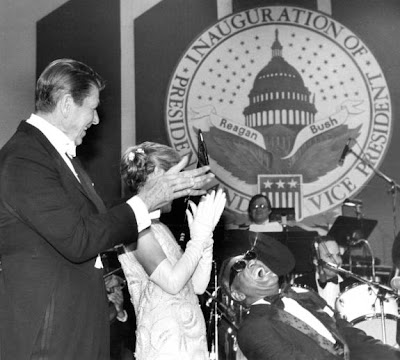 |
| The Kennedy Center is located on the banks of the Potomac River near the Lincoln Memorial in Washington, D.C. |
It is the busiest performing arts facility in the United States and annually hosts approximately 2,000 performances for audiences totaling nearly two million; Center-related touring productions, television, and radio broadcasts welcome 20 million more. Now in its 40th season, the Center presents the greatest examples of music, dance and theater; supports artists in the creation of new work; and serves the nation as leader in arts education. With its artistic affiliate, the National Symphony Orchestra, the Center’s achievements as a commissioner, producer, and nurturer of developing artists have resulted in over 200 theatrical productions, dozens of new ballets, operas, and musical works.
It represents a public-private partnership, since it is both the nation's living memorial to President John F. Kennedy and the "national center for the performing arts", which includes educational and outreach initiatives, almost entirely paid for through ticket sales and gifts from individuals, corporations, and private foundations.
Designed by architect Edward Durrell Stone, it was built by Philadelphia contractor John McShain and is administered by a bureau of the Smithsonian Institution. It receives federal funding each year to pay for the maintenance and operation of the building.
Two months after President Kennedy's assassination in November 1963, Congress designated the National Cultural Center (designed by Edward Durell Stone) as a "living memorial" to Kennedy.
 |
| Sen. J. William Fulbright, D-Ark., right, talks with architect Edward Durell Stone outside the Kennedy Center for the Performing Arts in Washington, circa 1972. |
Overall, the building is 100 feet (30 m) high, 630 feet (190 m) long, and 300 feet (91 m) wide. The Kennedy Center features a 630-foot-long (190 m), 63-foot-high (19 m) grand foyer, with 16 hand-blown Orrefors crystal chandeliers (a gift from Sweden) and red carpeting. The Hall of States and the Hall of Nations are both 250-foot-long (76 m), 63-foot-high (19 m) corridors. The building has drawn criticism about its location (far away from Washington Metro stops), and for its scale and form,[1] although it has also drawn praise for its acoustics, and its terrace overlooking the Potomac River.[1]
Cyril M. Harris designed the Kennedy Center's auditoriums and their acoustics.[3] A key consideration is that many aircraft fly along the Potomac River and overhead the Kennedy Center, as they take off and land at the nearby Ronald Reagan Washington National Airport. Helicopter traffic over the Kennedy Center is also fairly high. To keep out this noise, the Kennedy Center was designed as a box within a box, giving each auditorium an extra outer shell.[3]
The Center made its public debut on September 8, 1971, with a gala opening performance featuring the world premiere of a Requiem mass honoring President Kennedy, a work commissioned from the legendary composer and conductor Leonard Bernstein.
Two tableaus are at the plaza entrance of the Kennedy Center by German sculptor Jurgen Weber. On the east side of the plaza at the entrance is a display of nude figures in scenes representing war and peace, called War or Peace. The piece (8 x 50 x 1.5 ft.) depicts five scenes showing the symbolism of war and peace: a war scene, murder, family, and creativity.[4] On the west side is America which represents Weber's image of America (8 x 50 x 1.5 ft.). Four scenes are depicted representing threats to liberty, technology, foreign aid and survival, and free speech.[5] Created between 1965-1971, the tableaus were a gift to the Kennedy Center from the West German government. It took the artist four years to sculpt the two reliefs in plaster, creating 200 castings, and another two years for the foundry in Berlin to cast the pieces. In 1994 the Smithsonian Institution's Save Outdoor Sculpture! program surveyed War or Peace and America and described them as being well maintained.[4][5] Another sculpture Don Quixote by Aurelio Teno is outside the building.
Marvin Gaye performed here in May 1972.
In 1986, Ronald Reagan and his wife attended the Kennedy Center Honors ceremony in which Ray Charles was one of the honored artists.
 |
| Ronald and Nancy Reagan applaud Ray Charles performing at the inaugural ball on January 20, 1981. |
Jerry performed here
4/13/75 early and late shows
- ^ a b c Weeks, Christopher (1994). AIA Guide to the Architecture of Washington, D.C., Third Edition. Johns Hopkins University Press.
- ^ Roth, Leland M. (1982). A Concise History of American Architecture. Westview Press. p. 337. ISBN 0064300862.
- ^ Raichel, Daniel R. (2000). The Science and Applications of Acoustics. Springer. p. 252. ISBN 0387989072.
- ^ a b Save Outdoor Sculptures! (1994). "War or Peace, (sculpture)". Save Outdoor Sculpture, District of Columbia survey. Smithsonian Institution. Retrieved 10 November 2011.
- ^ a b Save Outdoor Sculptures! (1994). "America, (sculpture)". Save Outdoor Sculpture, District of Columbia survey. Smithsonian Institution. Retrieved 10 November 2011.


This comment has been removed by a blog administrator.
ReplyDelete